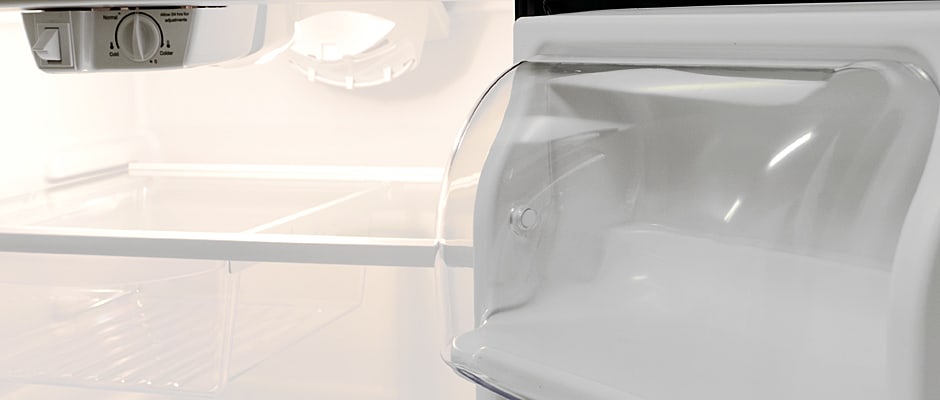Pros
Cons
Introduction
Design & Usability
Traditional design, on a budget.
This is, at its core, a purely functional fridge. Drawers slide open, control knobs turn, bulbs light up: everything works. Of course, just because something works doesn't mean it's necessarily going to look good doing it. The black plastic handles, as well as the black matte sides, clash with the stainless front, and the stuck-on logo doesn't feel very high end.
{{photo_gallery "Front", "Handle", "Fingerprints", "Interior", "Fridge", "Controls", "Crisper Drawer", "Fridge Door", "Freezer", "Freezer Door", "Side", "Back"}} On the inside, the combination light/control unit takes up a lot of space and doesn't even sit flush with the fridge ceiling. The plastic drawers aren't terribly smooth, and shelves are held in place loosely enough that they wiggle around when touched. Main shelves can't hold spills, and customization is nearly impossible. Sure, the two full-width fridge shelves can be moved around, but the choices for placement are limited. The doors possess only walled shelves with removable plastic fronts, where dripped maple syrup and salad dressing will pool.
Though lacking attention to detail, it's a safe, comfortable layout that won't surprise or intimidate anyone. Access to all the different zones is fairly open, even the space below the deli drawer, a traditionally tight fit with limited practicality. It may not be the most attractive fridge out there, but it still presents a stainless steel option for consumers on a budget.
Performance & Features
Pretty consistent, and very efficient.
For a budget model, this Frigidaire's fresh food compartment was surprisingly on task. There was very little temperature variation over time, a good place to start when it comes to food preservation. It had a marked increase in warmth from top to bottom, though, even more so than usual. A little extra heat at the bottom can be okay—most produce is meant to be stored at a slightly warmer temp compared to other refrigerated goods—but this was a little more than is typical. Don't store dairy down there.
The freezer, on the other hand, had some issues. Temperature consistency wasn't awful, but it also wasn't nearly as good as in the fridge. Even though we set the thermostat to the manufacturer's recommended setting, it ran several degrees warmer than 0ºF during our testing. Temperatures varied from top to bottom, too, so we'd recommending turning the temperature down if you don't want to risk freezer burn.
In all other respects, the product was usually just below average: moisture retention, freezing times, and storage space weren't anything to write home about. It is really cheap to run, though that efficiency comes at the cost of having no icemaker or water dispenser. That lack of extra features is par for the course with top freezers in this price point, though, so it's not too surprising.
Before You Buy
A bit better than your average low-cost top-freezer.
Compared to other budget fridges with a stainless finish, the Frigidaire FFHT1725PS offers good performance for a modest price. With fridge consistency and excellent efficiency rates as its two biggest strengths, this is a Frigidaire that gets the job done at a pure and basic level. Most online retailers offer it up for about $625, roughly $175 less than the advertised MSRP. For such a reasonable figure, budget-conscious consumers looking for an space-conscious top freezer should definitely check this one out.
The Ice Cold Truth
Design and aesthetic are important to many shoppers, but our rankings are based purely on measurable data. After being put through its paces in our gamut of thorough tests, the Frigidaire FFHT1725PS managed to produce the sort of results we expected from a $799 fridge. It's not good enough to win any prizes, but it did what it was supposed to, enough that we were actually pleased with the results.
Temperature Performance
Fresh good, frozen bad.
The controls on this machine are typical of a low-end fridge: two knobs, one in each section, with an arbitrary scale going from "cold" to "colder." As per usual, we set that sort of thermostat to the manufacturer's recommended setting, in this case labeled "Normal" and marked with an asterisk. Unfortunately, the recommended setting proved to be just a bit too warm in the fridge: our sensors picked up readings of 38.36ºF, 39.76ºF, and 44.29ºF in the top, middle, and bottom, respectively. You can adjust for this simply by turning down the thermostat a bit—though you'll need an external thermometer to calibrate accurately—but even so, a shift of almost six degrees is way more substantial than desired. Fortunately, consistency in the fridge was a strength. We recorded an average shift of 0.18 degrees over time, a very steady amount that should make up for some of the temperature issues.
The freezer, on the other hand, was just disappointing. At its coldest, the average temperature was 4.4ºF at the top, with a balmier 9.53ºF at the bottom. That's only slightly less of a shift than in the fridge, and in a space roughly two thirds shorter to boot. Consistency was less reliable here, as well: an average degree shift of 0.5 to 0.74 degrees isn't awful, but combine it with the wide spatial temperature range and you've got freezer burn written all over.
{{photo_gallery "Fridge Temperature", "Fridge Temp Graph", "Freezer Temperature"}}
Moisture Retention
Didn't expect much, and weren't surprised by the results.
The two crispers in this fridge aren't very large, and that's a good thing. Having moved the humidity controls to their most retentive setting, our test materials lost an average of 0.2 grams of moisture over time. It's not awful, but it's below average nonetheless. The amount of produce you can fit into the drawers—don't go crazy at the store—shouldn't be more than you can consume within just a few days, which will likely be how long the fruits and veggies will stay fresh.
Freezing & Thawing
Neither stellar, nor sub par.
It still surprises us that a freezer as compact as the one in this Frigidaire can take so long to chill something. Our room temperature test materials took one hour and 49 minutes to officially freeze, slightly longer than average. Thawed meat and fish may suffer a decrease in textural quality, so don't stock up on high-priced cuts of beef unless you plan to eat it all in one sitting.
Fortunately, the insulation in this model works just fine. After all our other tests were completed, we unplugged the Frigidaire to simulate a power outage. After 36 hours (keep in mind that we never opened the doors during this time), our test materials had only warmed to 27.34 degrees. That's still thoroughly frozen; as long as you've got a decent electric company working in your neighborhood, you groceries should make it through just fine.
{{photo_gallery "Freezing Graph", "Power Loss Graph"}}
Storage Space & Energy Efficiency
Standardized storage with super electricity savings.
As we mentioned earlier, this fridge has a very traditional layout. Three full-width shelves, a deli bin, and two crispers make up the fridge proper, with an assortment of four non-adjustable shelves and a dairy bin on the door. After subtracting space for obstructive items such as the controls and light bulb, we determined that there's a total of 9.72 cubic feet of usable fresh food storage. It's neither cavernous nor cramped, a decent space suitable for an apartment with multiple roommates.
{{photo_gallery "Fridge Storage", "Fridge Door Storage"}}
The freezer is very basic; even without an icemaker, you won't be able to fit a ton in here. The main cavity is by a single wire shelf. The door boasts two identical shelves which offer a small amount of extra storage, but not a ton. On the whole, you've got 2.71 cubic feet of usable space. Like the fridge, it's not a ton, but should be enough for you to get by unless you subsist purely on a diet of television dinners and frozen pizza.
{{photo_gallery "Freezer Storage", "Freezer Door Storage"}}
The best part about this fridge is undeniably its energy efficiency. For one year of power, you'll have to pay just $20.07. That figure is derived using a rate of $0.09 per kWh, so based on your local bill, that annual fee could go up or down, but it's going to be proportionately low regardless. Taking all of that power and spreading it out over the usable storage, we also found that each cubic foot requires just 0.06 kWh. That's exceptionally low, among the lowest we've seen on an average-sized fridge.
{{photo_gallery "Power Data"}}
Meet the tester
Matthew is a native of Brockton, Mass., and a graduate of Northeastern University, where he earned a degree in English and Theatre. He has also studied at the Gaiety School of Acting in Dublin, Ireland, and spends time pursuing a performance career in the greater Boston and Cambridge area.
Checking our work.
Our team is here to help you buy the best stuff and love what you own. Our writers, editors, and experts obsess over the products we cover to make sure you're confident and satisfied. Have a different opinion about something we recommend? Email us and we'll compare notes.
Shoot us an email


